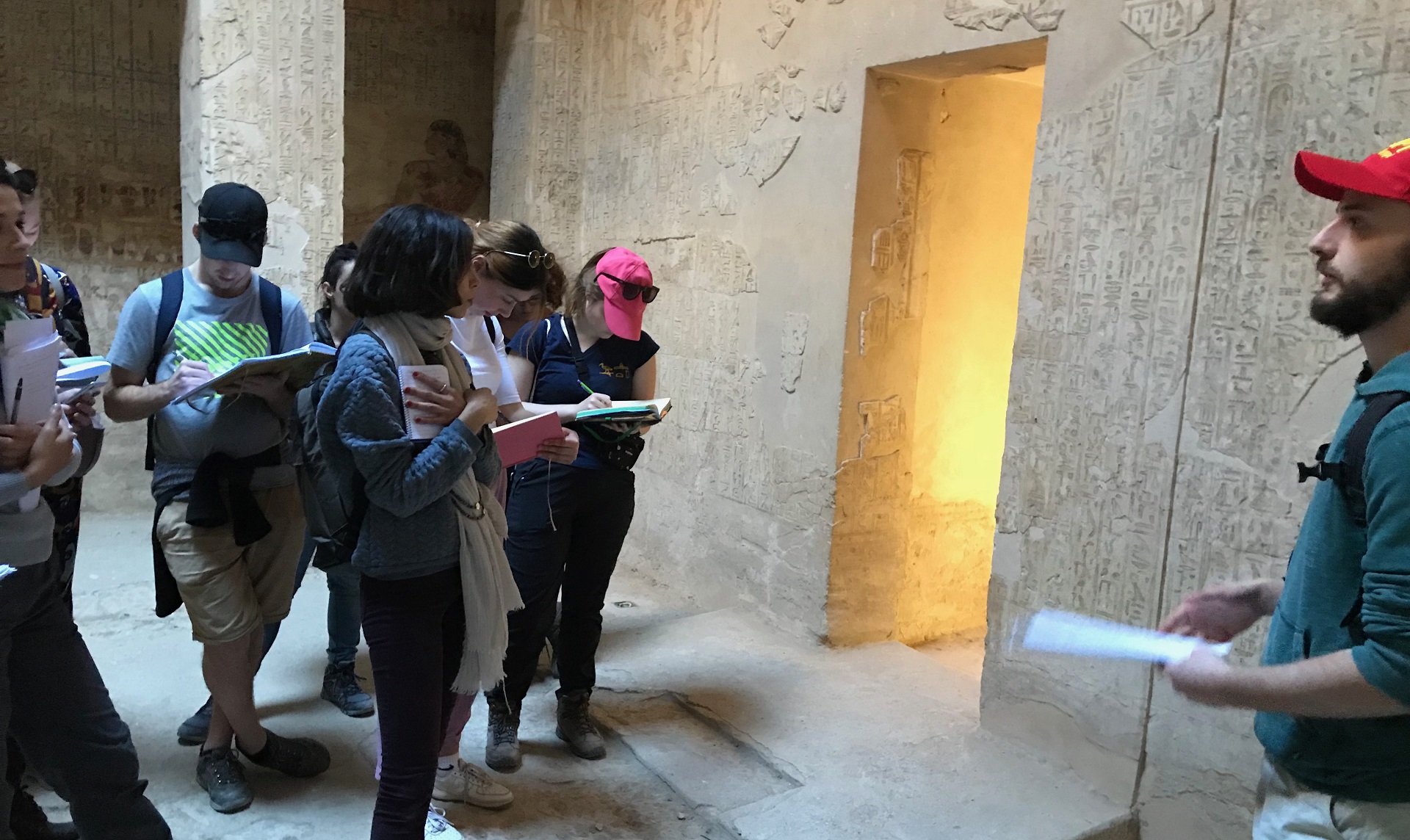Week 3: 19–25 January, 2020
The first day of our third week started by heading from Port Said to Alexandria. After a three-hour trip we arrived at Alexandria, where we visited the Catacombs of Kom el-Shuqafa. Marleen gave us some information about the site and then we entered the catacombs. We focused on the decoration of the main burial chamber, which was very interesting because it combines Greek, Egyptian and Roman styles of iconography. Afterwards, we had the opportunity to explore the catacombs, which was an amazing experience. After a brief visit to the Serapeum, we met Marie Dominique Nenna at the CEAlex (Centre d’Études Alexandrines). She gave us a very interesting and very detailed lecture not only about the CEAlex but also about the history and archaeological context of Alexandria. Afterwards we went to our hotel, from where we had a beautiful view over the bay of Alexandria (fig. 1).

The next day we visited the Citadel of Qaitbay which is located exactly where the great lighthouse (pharos) of Alexandria once stood. It is a fortress established in 1477 AD with a majestic view of the Mediterranean. Our next stop was at Kom el-Dikka, where we saw the ancient Roman theater and we had the opportunity to experience its incredible acoustics (fig. 2). We also saw the ancient baths and classrooms. Finally we visited the Bibliotheca Alexandrina where we had a very nice tour of the library. When the tour ended, we had the opportunity to visit the Antiquities Museum and wonder around in the great library. At the end of the day we returned to Cairo.

The next morning we all went to the Egyptian Museum in order to finish our museum assignment. In the evening we attended a very interesting lecture at the DAIK about the Grand Egyptian Museum (GEM). We received valuable information about the museum’s goals, its components and its main collections. At the end of the talk, we had a taste of how the museum will eventually appear, through a video that the speakers had prepared.
Thursday we got our assignments finished and our site presentations ready. In the evening Dr. Fayza Haikal spoke at NVIC about the cultural survival of ancient Egypt in the 21st century. She gave many examples of elements that could originate from ancient Egyptian culture, concerning rituals, games and language.
On Friday we met very early at NVIC, ready for an 8 hour drive to Luxor. Our trip to the south could finally begin. We arrived in the late afternoon at our hotel, which will be our home for a week. On Saturday we had a busy day, starting with the Valley of the Kings. The first tomb we visited was the tomb of Seti I, which was absolutely spectacular. Afterwards we visited some more tombs in the valley, but unfortunately only the tombs of later kings (from 19th Dynasty onwards) were open. But among them were some other very impressive tombs, as those of Merenptah and Ramses VI. Afterwards we headed to the West Valley in order to visit the Tomb of Ay (fig. 3). Ay reigned briefly after Tutankhamun and his tomb is remarkably similar to the one of Tutankhamun.

After lunch we headed to Deir el-Bahari to visit the famous temple of Hatshepsut. Marleen first gave us some information regarding the temple and its surroundings, after which we went up to the upper terrace which has only recently been opened to the public. Daniela gave her site presentation about this terrace (fig. 4), after which we visited the rest of the temple. We had a chance to see the famous scenes from the expedition to Punt conducted by the queen, but also her birth scenes were very interesting. Next to her temple, the temples of Mentuhotep II and Thutmosis III were still visible but unfortunately not open to the public. After our visit to the temple, Matthieu took us to the nearby tomb of Pabasa, which dates to the 26th dynasty. The tomb is decorated with some interesting scenes, such as that of beehives, which is an extremely rare scene. We ended the day with a visit to Carter’s house, which gives a feel for the circumstances in which Howard Carter lived during his many years of work in Thebes. In the garden we visited an exact copy of the tomb of Tutankhamun, which was a nice way to end our first day in the south.
Katerina Sofianou & Eleonore Nicolaï


